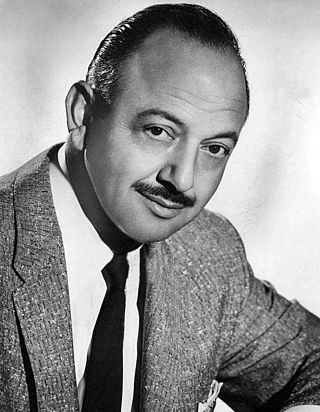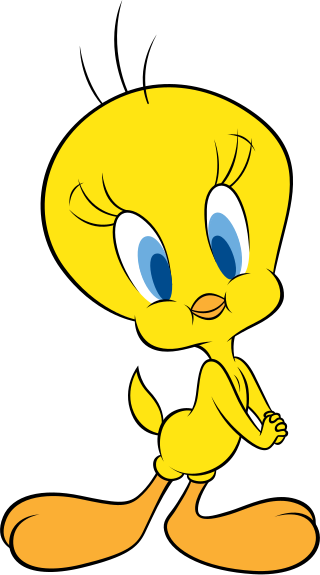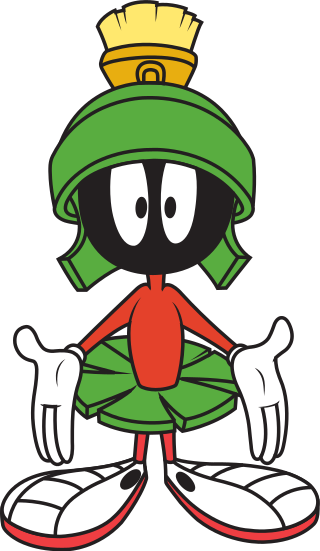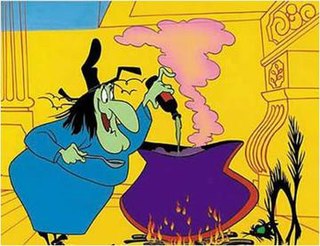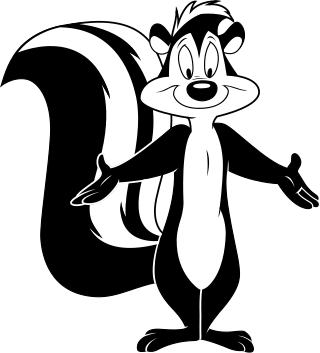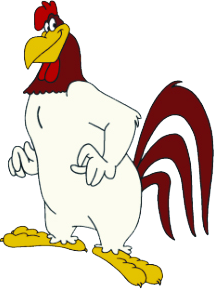Plot
This cartoon begins as Bugs Bunny once again gets lost when he is tunneling to his vacation spot. He accidentally ends up near Loch Lomond, Scotland, instead of the La Brea Tar Pits, having once again not "made that left toin at Albahkoiky!", and mistakes a Highlander named Angus MacRory playing the bagpipes for a lady being attacked by a "horrible monster". Bugs jumps MacRory, trying to rescue the "woman", and in the process he smashes his bagpipes to pieces.
MacRory becomes enraged that his bagpipes have been absolutely ruined. He yells at Bugs, and is about to threaten him, but Bugs figures out that MacRory is actually a man, and when MacRory asks him what was wrong with that, Bugs tells him (after asiding "'What's wrong?' he says...") that he can't go around wearing a kilt claiming it is indecent (Bugs obviously thinking is a skirt) before throwing a barrel over MacRory.
Bugs then asks MacRory for the directions to the "La Brea Tar Pits in Los Ahn-galays", at first confusing then causing the Scotsman carry out his threat on Bugs with a blunderbuss, telling the rabbit, "There are no La Brea Tar Pits in Scotland!" Realizing now the location he is in, Bugs bids MacRory, "Eh, what's up, MacDoc?", and runs for it just as MacRory shoots. MacRory chases after the bullet and picks it up ("It's been in the family for years"), reloads the bullet back into his gun, and shoots at Bugs repeatedly, who dives back into his hole (which MacRory fires into) and comes back out elsewhere moments later thinly disguised as an elderly Scotsman, accusing MacRory (whose last name is revealed by the disguised Bugs) of "poaching on [his] property". MacRory doesn't believe him, however, and challenges him to a traditional Scottish duel — a game. Bugs, upon hearing this, sets up a card game. MacRory corrects him, stating the challenge is a game of golf; as they head off, Bugs then asks MacRory "Have it your way Mac, but don't ya get a little tired running them 18 bases?"
Throughout the golf game, Bugs continually outsmarts the Scotsman. On the first hole, Bugs, focusing on swinging the ball, looks down at the Scotsman for tapping his foot impatiently. MacRory stops tapping, and sheepishly hides his foot behind his other leg. After declaring "FORE!", Bugs takes his swing and the ball veers off course, so Bugs quickly digs another, bigger hole to earn a hole in one (with the real hole shown to be off in the distance). Bugs then nails MacRory's ball to the tee so that it won't go anywhere ("Fore!" "Four? Three-and-a-half."); but MacRory gets a hole in one anyway (through ending up in the hole himself), to Bugs' protests ("A hole in one? Why, you little cheater! You little four flusher! Why, you can't...").
On the 8th hole, MacRory laughs at Bugs, whose ball has fallen shorter of the hole than MacRory's. Bugs then turns his club into a pool cue, and hits a bank shot into the hole, causing MacRory to break his own club in half in anger.
Later, MacRory laughs again as Bugs struggles to get his ball out of a bunker. Once he gets the ball out and gets it into hole 16 after multiple strikes, Bugs figures how many strokes to write on his scoreboard. After he goes through elaborate motions of doing addition in the air, he announces his score: "Two." MacRory, not believing Bugs at all, counters: "Two? FIFTY-FIVE!" Bugs immediately sets up a fake auction, with Bugs acting as the auctioneer and continually lowering the score, until MacRory offers "one" as his "final offer", much to the dumbfounded Scotsman's surprise.
At the last hole, MacRory gets a hole in one. Bugs meanwhile misses the hole altogether and quickly digs a channel with his club for the ball to roll through into the hole. After checking his score, Bugs then declares himself the winner, whereupon the Scotsman angrily denounces the rabbit's earlier action as cheating. But Bugs defends himself with a list of phony "historical" citations where his action had also supposedly occurred: "Cheating? Why, that identical situation occurred in the New Hebrides Open. Kaduffleblaze versus Fuddle in 19-aught-18. And what about Fradis versus Ginfritter? Hah! Bizbo versus Stoigen in the Casablanca Amateur. Cheating, indeed! The noive!"
The Scotsman concedes that "the weight of evidence is greatly against [him]", but he still claims that he can't be beaten when it comes to playing bagpipes, and he grabs the instrument to demonstrate. After playing, he dares Bugs to try and top that — which, to MacRory's shock, the rabbit does by dressing like a Scot and playing not only the pipes, but also a trombone, a saxophone, a trumpet, two clarinets, cymbals on his feet, and a bass drum on his head with the beaters tied to his ears, in the manner of a one-man band. Bugs takes a final glimpse at the audience and waggles his eyebrow, before an iris-out.

